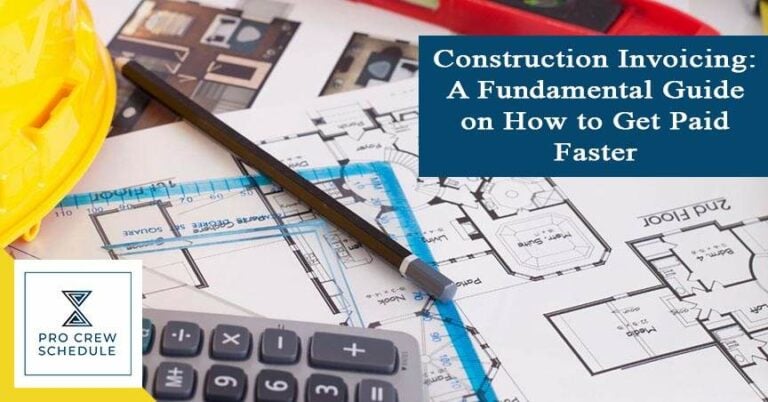Managing construction projects often involve many teams – from general contractors subcontractors to suppliers and trade partners; it is no surprise that on-time payment releasing and progress billings are a problem in the industry. Getting paid in the construction business takes longer than in almost any other sector – validating each milestone to ensure proper payments go through a long and complicated series of steps. To begin with, a contractor must complete time-consuming and information-intensive payment applications. And, while you anticipate the release of those payments, contractors must find a way to cover all of the initial costs required to get a project started and proceed with the subsequent activities.
Billing the proper invoices may be the essential step in managing your company’s receivables and solving those late payment problems. Construction companies cannot afford to ignore invoicing when cash flow is critical to profitability and project delivery success. Project managers require timely billing and invoices that communicate what’s due to keep cash flowing in – to minimize disputes and get faster payments. However, it is easy to get into trouble with overhead, notoriously slow payments, and the nature of a credit-heavy industry. Creating accurate and timely construction invoices can assist you in getting paid faster and avoiding the nightmare scenario of running out of cash.
In this article, let us go into the basics of a construction invoice and how a proper invoicing process can help you get back on track with managing your receivables and cash flow.
What is a Construction Invoice?
When payment is owed for work performed, a contractor, subcontractor, or supplier sends an invoice to their clients. Invoices formally request payment for a specific amount and create a payment obligation to the client, resulting in creating an account receivable for the contractor. As a result, it contains payment terms, such as the due date and any discounts.
Each construction company manages its invoicing differently, and the relevant information on an invoice can vary greatly depending on the work being performed.
When Should Contractors Send Their Invoices?
Construction contractors should, in reality, try to send their invoices as soon as possible once a specific milestone is completed. Of course, processing takes time. However, a week’s delay in invoicing does not always equate to a week’s delay in receiving payment. As time passes, more work accumulates, making it easier for the contractor and the customer to lose track of what is owed and whether it was even requested. Invoicing late is the surest way to get paid late, and timely billing is more likely to get delivered on time.
What Information Should Be Included in a Construction Invoice?
Contractors should create detailed invoices that outline essential billing information, such as payment deadlines, an itemized list of services provided, and the total balance owed. This section has laid out a nine-step process for submitting an invoice that can help optimize cashflows and streamline your project management for construction.
1. Indicate the Document as an Invoice
It is critical that you clearly label the document as an invoice in the header so that the clients know what it is specifically for. Use a large, bold font for the word “Invoice.”
2. Include Your Company’s Name, Address, and Contact Information
Include your company’s information and business logo in your header. Although it may appear obvious, including your company name is an essential step in identifying the invoice for your client. The most crucial branding step is naming your company, ensuring that your customers know who to pay for the specific invoice.
3. Add the Client’s Business Information
Add your client’s contact information below the header. Check with each of your clients to determine the correct billing contact for your invoices. Having an updated list of client information or a client directory reduces the risk of delays due to the invoice being addressed incorrectly to the wrong person.
4. Designate a Unique Invoice Number
Every invoice you send should be assigned a unique invoice number that can serve as a reference number when keeping records for everyone. It also makes tracking and reviewing the specific invoice easier if a payment problem arises.
5. Add the Invoice Date
Adding in the invoice date lets you see when the invoice was sent and record how long it takes for the client to settle the payment.
6. Provide A Brief Description of the Goods or Services Rendered
Include a brief or a line-item description of the work you provided, including the quantity for the service or goods rendered. This will allow both you and the clients to see which milestones are already completed and should be paid, reducing the risk for double billing or overpayment.
7. List the Total Amount Due
List the total amount owed for the bill, including applicable tax, in the bottom section of your invoice. Make this document section stand out by using a large font, bold lettering, or different font color.
8. Indicate Your Payment Terms and Methods
Include your payment terms, as well as the payment methods you accept, in your invoice. You should also include information about your late fee policy if you have one. Remember to include your payment information so that your clients know where to send or transfer money.
9. State the Payment Deadline
In large, easy-to-read font, write the payment deadline. Clearly indicate the specific information about payment due date to avoid confusion and late payments. Some payment systems, such as cheques, take longer than others.
How to Keep Your Invoicing Practices Efficient for Faster Payments
Every construction company has its invoicing procedures, and everyone knows what works best for them. Nonetheless, we have listed down some of the best practices in construction invoicing.
Send Invoices on Time
While you need to send your invoices as soon as possible, keep in mind that you have to ensure that the specific service indicated in the invoice is complete. When invoices are sent late, payment is almost always late. Late invoices also tend to cause more confusion than timely invoices.
Ensure That Your Invoice is Clear and Detailed
Make sure that each customer understands what they are paying for. It’s a good idea to include just enough information to back up the requested payments, but not so much that the invoice becomes illegible.
Maintain Proper Documentation
Keep an organized record of everything related to the invoice. Keep all project receipts and timesheets. When it comes to managing construction, documentation is essential. Contractors are compensated for the work they document rather than perform.
Provide Incentives for Early Payments
Offering discounts if the invoice is paid before the due date is a simple way to expedite payment. This simple modification to your payment terms often motivates the clients to keep payments updated and speed up the process.
Add Late Payment Penalties
Contractors can take a proactive approach by including late-payment penalties in their contracts. These can consist of a percentage of the accumulated interest for past-due amounts. It may also specify your right to recover the costs of collecting past-due payments.
Use Construction Scheduling Software
Using spreadsheets to keep track of who owes you what and when is a challenging task in itself. Using paper invoices is a time-consuming and nearly impossible task. On the other hand, contractors can be confident that their on-site progress is being invoiced on schedule, keeping cashflows efficiently flowing. Construction scheduling software allows clear visibility on every aspect of your project, including task progress and invoice documentation. Looking at this valuable information can help you predict what’s coming due and where uncollected receivables may impede your cash flow. Having a centralized location to look at will provide your construction company with a single source of truth. This keeps everyone up to date about where projects are and who has already been billed.
Be Proactive
When no one is responsible for being proactive with collections, it is a common fatal flaw for contractor cash flows. The accounting may assume that project managers will follow up. Meanwhile, an unpaid invoice sits on a customer’s desk because no one has spoken to him in two months. Each construction company can decide what works best for their processes, but the best is often the simplest. Giving your customers a gentle reminder can help in reducing pending payments. They’ll send over a check as soon as they get a nudge — they need to know someone is missing it.
Maintain Consistency
Maintaining consistency with expectations is an essential part of creating a delightful experience. When constructing a new home or remodeling an existing one, keep in mind that clients are frequently unfamiliar with normal project progression. Consistency in your payment collection process can provide familiar and grounding touchpoints along the way. Clients may even look forward to receiving an incoming invoice as a significant update on their project due to the trust you’ve earned along the way.







